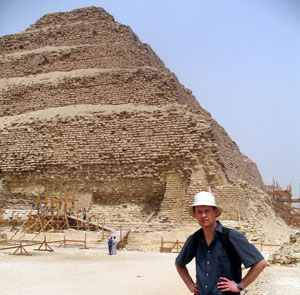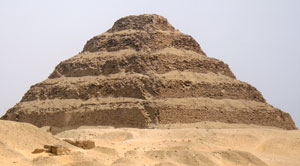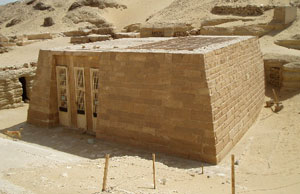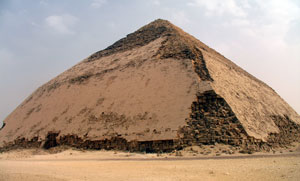

What is a Pyramid?
In Egypt there are two main pyramid shapes - step pyramids and true pyramids. But you can see pyramids all over the world, in places like Mexico and South East Asia.
Why have so many ancient peoples built similar shapes? Here you can learn about the shapes of pyramids and why they are those shapes.

Why are pyramids pyramid-shaped?
In ancient times, if you wanted to build a tall building, why couldn't you build it straight up, like a modern skyscraper?

Skyscrapers like the Empire State Building, which is 443m (3 times the height of the Great Pyramid), were made with modern materials like steel and concrete, as well as bricks and stone.
The picture below shows an old skyscraper being built in Chicago, starting with the steel frame. These frames give a lot of strength and allow you to build extremely tall structures. The tallest building in the world, the Burj Khalifa in Dubai, is an amazing 829m!

In ancient times, there were no steel girders or concrete. The Egyptians only had blocks of stone or mud bricks, and a weak cement made of clay. If the blocks or bricks were piled on top of each other, going straight up and very high like a skyscraper, they would have collapsed.
This means that when they built a new layer of a tall building, it had to be smaller than the layer below. If each layer is smaller than the one below, you end up with a pyramid shape. The picture below is a plan of the Step Pyramid from above, showing how each layer 'fits inside' the one below:


And so we end up with the Step Pyramid. Now we can see why pyramid-shaped buildings have been built all over the world - simply because that's the only shape you can get if you want a tall building, and you haven't got steel or concrete. On the right of this page you can see some of these pyramids, from other countries like Mexico and Cambodia.
The Step Pyramid
The Step Pyramid is the first of the Egyptian pyramids, built around 2600BC - that's 4600 years ago, about 100 years before the Great Pyramid. That's me in front of it in the picture to the left. It was the first large stone building built anywhere in the world, to bury the pharaoh Djoser. It is at Saqqara, in the desert south of Cairo.
You can see that the Step Pyramid is made of big steps, each about 10m high (the whole pyramid is 60m). So why was it built like this?
Before the Step Pyramid, pharaohs and other important men were buried in a tomb we call a mastaba. Mastaba is the Arabic word for bench, because the tombs are sort of bench shaped (see the photo to the right). Inside are rooms for treasures and wall paintings, and the burial chamber is underneath the mastaba, dug out of the ground.
The mastaba may have stood for the 'primeval mound'. According to Egyptian myth, all life began from a fertile mound that grew out of the water. They believed the god Atum created life here. They probably got the idea for this from what happened during the Nile flood every summer. When the waters began to drop, small mounds of mud would appear. Soon, new plants would start to grow, as if by magic. This made the Egyptians think of creation - of how all life began. It also reminded them of rebirth in the afterlife - of coming back to life after dying.
The pharaohs wanted to be reborn after they died, so they could live in the afterlife. Therefore the mastaba may stand for the primeval mound, helping them come back to life.
The bottom layer of the Step Pyramid is a mastaba, like the ones pharaohs had had before. But after it was built Djoser decided he wanted more layers on top - he wanted a taller tomb, perhaps to reach towards the sun god, Ra, in the sky. Some Egyptologists think Djoser decided earlier to make a pyramid, and the mastaba was meant to be hidden inside later layers of stone. This was to show that life after death was also underground - in the 'underworld', a hidden place.
True pyramids
After Djoser, two more pharaohs tried to build step pyramids, but they were not completed. There are some small step pyramids in Egypt, such as the queen's pyramids next to Menkaure's pyramid at Giza. But very soon, pharaohs decided to switch to what we call a 'true' pyramid shape. This means a 3D shape with a square base, and four triangles on the sides.

The first pharaoh to construct true pyramids was Sneferu, the father of Khufu (Khufu was buried in the Great Pyramid). Sneferu first had a step pyramid built at Meidum, but decided to have a new, true pyramid built instead. Later on he even had the Meidum pyramid converted to a true pyramid.
The Bent Pyramid
Sneferu's next pyramid was meant to be a true pyramid, but it had problems, It started off very steep - too steep, in fact, and it started to collapse inside. So they carried on building it at a shallower angle. The pyramid ended up with two angles, which is why we call it the Bent Pyramid (see photo below).
Sneferu wasn't happy with this, so he ordered his workers to build a third pyramid (they must have been pretty fed up by now!). This is what we call the Red Pyramid, because the limestone used for it is slightly reddish in colour. The Red Pyramid was the first ever true pyramid, with a proper triangle on each side (see photo below). And so the age of the true pyramid was born - the next one was the Great Pyramid.

mastaba of Khnumhotep and Niankhkhnum (2 brothers), near the Step Pyramid at Saqqara

papyrus painting of the primeval mound - two goddesses are pouring water around the mound
Pyramids around the world
Quite a few ancient civilizations built large pyramid-shaped buildings, as tombs or temples. These are not usually true pyramids, with smooth, simple tringles on four faces; they are more like step pyramids. Below are a few examples.
Chichen Itza in Mexico - a group of temples built by the Mayans, who used it for ceremonies from about 550-800AD (about 3,000 years after the Great Pyramid was built). The most famous is the Kukulkan Pyramid (see above), also known as El Castillo (the castle in Spanish). It is 24m high and now one of the new seven wonders of the world. It is believed it was used for astronomical purposes.
The Pyramid of the Sun - built by people known as the Teotihuacanos, in the city of Teotihuacan, 30 miles north of Mexico city. It is 225m wide - about the same as the Great Pyramid - but only 75m high, so about half the height of the Great Pyramid.
The Pyramid of Prasat Thom - built at Koh Ker, around 930AD, by the Khmer civilization of Cambodia (in eastern Asia). It is a temple, now overgrown by the jungle, but quite large - 75m high - and with seven levels.
Modern Pyramids
Nowadays many people still find the pyramid shape very attractive, and we see lots of modern pyramids. Below are photos of the Louvre Pyramid in Paris - a glass cover for the entrance to the museum - and the Luxor Hotel in Las Vegas, which is one of many 'copies' of famous buildings in this US city, meant to attract tourists.
The Louvre Pyramid
Luxor Hotel, Las Vegas
Click on the picture below to see a fascinating chart comparing the sizes of many pyramids around the world (courtesy of Wikipedia):







